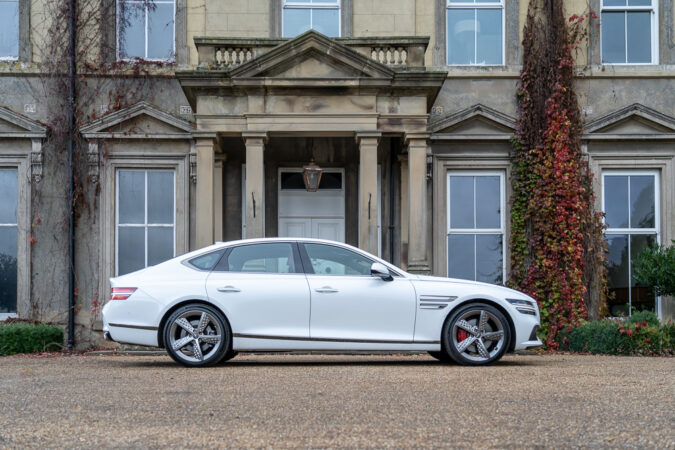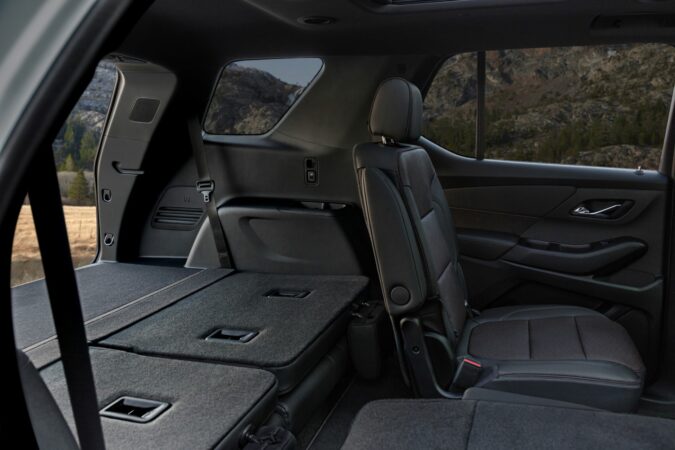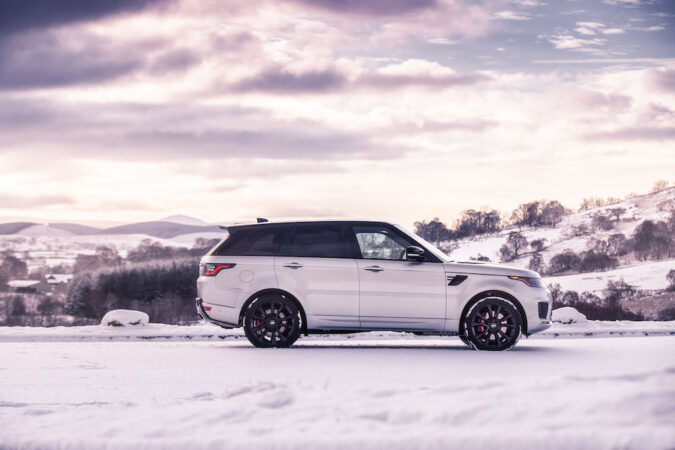If you live in a large city or a neighborhood with winding streets and sharp curves, knowing the typical vehicle size such as how wide are cars can help you choose the right vehicle.
Surprisingly, bigger cars predominate on the nation’s highways and at its automotive dealerships. Larger vehicles make you feel safer and sometimes cost less for insurance. However, larger or heavier vehicles can always present a serious threat to other drivers and pedestrians on the road.
Over time, demand and geographic considerations have impacted car sizes. Therefore, before you purchase a car, it is crucial to understand the average vehicle length in full.
- Length Of Car
- Width Of Car
- Full-Size vs Standard Car
- Wheelbase Measurement
- Frequently Asked Questions
Average Length Of A Car
A car typically has a length of 14.7 feet or so, if you’re wondering how long is a car. Standard cars and trucks are normally between 10 and 18 feet long, though this might vary between manufacturers and types.
A Mini Cooper is about 10 feet long, whereas a medium sedan is roughly 14 feet long. The shortest passenger vehicle in the nation is the Chevrolet Spark, which is about 12 feet long.
The longest is the Rolls-Royce Phantom, which is almost 20 feet long. A full-size vehicle is roughly 15.7 feet long. The length of a car is increased by elements like cargo space and passenger space.
When considering the typical car length, safety will be the first thing that comes to mind. We frequently think longer cars are safer.
The truth is that because of advancements in engineering, materials, and construction, smaller cars can be as safe as larger ones. The size of autos has increased nationwide every ten years. The other major elements affecting the length of the car you buy are your local area and fuel efficiency.
One factor that every consumer places importance on is fuel efficiency. Larger cars also don’t cost as much to insure. Despite all of these things, in the end, it comes down to personal preference.
Average Width Of A Car
The typical width of a car is about 5.8 feet. The aerodynamic performance or even the additional safety elements frequently cause the width of the car to vary.
If you live in a large city or a neighborhood with winding streets and sharp curves, knowing the typical vehicle size such as how wide are cars can help you choose the right vehicle. With mirrors folded, the Tesla Model X, which measures 7.4 feet wide, is the widest car available outside of the ultra-luxury segment.
More than the breadth of ordinary parking places, a vehicle’s width can be increased by features like side airbags or lane departure sensors.
Full Size vs Standard Car
When it comes to the size of a car and also related to how wide are cars, 5 people can fit in a standard car with room to spare and at least one or two large suitcases. For extended car trips, these larger vehicles often offer comfortable rides and plenty of legroom.
Standard vehicles frequently include more facilities and amenities than compact cars for drivers who place a high priority on comfort.
Since there is no agreed-upon definition of what constitutes a standard car, a vehicle may be labeled standard by one rental agency while being classified as mid-size or intermediate by another.
Standard cars, on the other hand, are generally acknowledged to be bigger vehicles that can accommodate at least 5 persons and numerous heavy baggage
Gas mileage is typically quite good in standard cars because most driving scenarios are excellent for average drivers. An ideal compromise between comfort, space, and gas mileage is a typical basic automobile.
How Wide Are Cars, Key Factors #1. What Qualifies As A Standard Car
Four or five persons can fit comfortably in a normal car, as well as some luggage. Compared to tiny cars, standard cars are roomier and larger. Additionally, they provide greater capacity for bags and more legroom.
Mid-size and intermediate vehicles are other names for standard vehicles. They belong to a size category that is sort of in-between, with one foot inside the economy class with its worse gas efficiency while the other is in the luxury sedan class with its better baggage space and extra frills like air conditioning.
Because of this, the majority of the time an ordinary car is a great option for average drivers.
In a conventional car, driving in the city or on a highway is equally simple and comfortable. With air conditioning, you will not be concerned about getting too hot or cold while traveling.
How Wide Are Cars, Key Factors #2. Maneuverability Of Standard Cars
On the issue of how wide are cars, standard cars are also more maneuverable and smaller compared to full-size cars or SUVs. This makes them easier to control in confined urban environments. A full-size car: what is it?
A standard automobile is bigger than a full-size car. It is the biggest four-door sedan car available that isn’t an SUV. Simply said, a full-size car is a car that is bigger than other cars. A full-size car is the best option for long-distance travel and carrying a lot of luggage without the need for a minivan or SUV.
Full-size cars often cost more than smaller cars, so you’ll get more amenities and pleasures with them, but you’ll also pay more for gas.
Standard vehicles provide better gas mileage than full-size cars. In some circumstances, they may also be more difficult to drive, particularly in congested urban areas.
However, if you want to travel farther and carry a lot of luggage, a full-size automobile can be ideal for you.
How Wide Are Cars, Key Factors #3. The Advantages Of Standard Cars
When driving with more than three passengers and some bags or luggage, a regular car is preferable over a tiny or economical car.
Standard vehicles are preferable for longer trips that could last several hours because they provide greater space for both people and luggage.
Standard vehicles are adaptable. It’s difficult to make a mistake if you rent a normal car because they are made to be suitable for average drivers in typical conditions.
It is a reliable option with great gas mileage and a size that is both roomy for your bags and people while also being manageable in traffic. You can easily drive on the highway or in the city.
The majority of autos are comfy. Compared to tiny or economical cars, they typically have more luxurious features and greater room for passengers to spread out.
A basic automobile is ideal for you if you are unsure of what you want but need reliable cars (new or used) that will be there for you in any circumstance, has all the amenities you require, has enough space for all of your belongings, and gets good gas mileage to keep your expenditures down.
How Wide Are Cars, Key Factors #4. What Qualifies As A Full-Size Car
On the issue of size and how wide are cars, the largest sedans available are full-size vehicles, which are also the largest vehicles available before considering vans and SUVs.
A full-size car’s most noticeable characteristic is, well, its size. Full-size vehicles are bigger than regular vehicles. To have this much inner area, they must be. However, this might occasionally make it more difficult for them to park and drive, especially in small areas.
All that size results in lower fuel economy and more expensive gas stations. For enthusiasts of full-size cars, including antique car owners and luxury car connoisseurs, it is all worthwhile.
Compared to regular cars, full-size vehicles frequently have more features, such as heating, air conditioning, satellite radio, as well as plenty of legroom.
How Wide Are Cars, Key Factors #5. The Advantages Of Full-Size Cars
The best thing about a full-size car is not simply its size, which allows you to transport friends and all of their luggage, but also the comfort and luxury these cars provide.
Again on the issue of how wide are cars, one thing to note is that full-size vehicles are large. Legroom and storage for your shopping bags won’t be a problem. This is practical for quick excursions, but it really shines for extended car trips with many of passengers. The extra room makes a significant difference.
Full-size vehicles are cozy. They have even more deluxe features than regular cars, and frequently the best amenities for enhancing comfort are included, such as heated seats, massage seats, as well as entertainment systems. You may anticipate a comfortable journey, a welcoming environment, and at least a few excellent features.
Driving a full-size car is enjoyable. You’ll probably love the improved performance that many full-size cars gain if you enjoy driving. A full-size car might satisfy your need for acceleration because, in many situations, increased size is accompanied by a bigger and more powerful engine.
Wheelbase Measurement
The length between the front and the rear wheel centers determines a car’s wheelbase. Due to this, it is smaller than the length of the vehicle when you measure it from front to back.
Wheelbases are frequently measured in millimeters, albeit occasionally in centimeters. North Americans typically measure theirs in inches.
You’ll need the following to measure the wheelbase:
For the wheelbase measurement of your car, not much is required. In truth, you most likely already possess all you require to begin. Immediately, the list of tools:
- Measurement tape
- Some chalk
Additionally, you’ll require a level workspace, such as a garage floor, a driveway, or on-street parking.
Now that you have a good understanding of how wide are cars, also check your local regulations to be sure you aren’t breaking any rules when using the roadway.
1. How To Measure The Wheelbase Of Your Car
It’s crucial to note that you can measure directly from one wheel to the other wheel without any chalk marks if you only want a general estimate of the wheelbase, but you’ll probably need a companion to hold the other end to get an accurate reading.
You can use chalk to measure with a little bit more accuracy and on your own.
- Place the car as level a surface as you can. The measurements you take may vary if you are on an uneven or mountainous surface.
- Make sure the car is in drive or in Park and that the parking brake is engaged. Ensure the front wheels remain straight and the steering wheel is straight.
- Take the square measure and place it against the wheel, making that the vertical axis is as close as possible to the center of the center cap. With your chalk, draw a line on the ground where the square’s base meets the road.
- Use a second square to make sure that you aren’t over or under-measuring if you’re not sure about the angle.
- Leave two chalk marks on the ground, one for the front wheel and one for the back.
- Measure the distance between the two chalk marks using your tape measure. This is the length of your wheelbase.
- To investigate and identify any alignment or tire wear issues, make the same measurements on the opposite side of the car. A body shop may be required to fix the issue if the wheelbases don’t line up on one side or the other.
2. Check The Door Sticker
Check the sticker inside your driver’s side door jamb to compare your measurements to the manufacturer’s specifications.
You should be able to discover the OEM’s wheelbase figures there along with the recommended tire pressures (you can find out more in our write-up on the tire pressure for Honda CRV and the Tesla Model 3 tire pressure) and the country of production of your car. Why is the wheelbase of a car significant?
It’s amazing how many characteristics of an automobile are influenced by its wheelbase. Interior space is frequently considered to be the most important.
The majority of a car’s interior is located between the wheels, so a vehicle with a long wheelbase will often have a roomier inside than a vehicle with a shorter wheelbase of the same length.
3. Long Wheelbase
Most of the time, car designers employ a long wheelbase to make the interior of the vehicle feel like one giant box, free of any obstacles. The designers can then make the most of the space available for both people and goods.
It’s important to remember that a lot of high-end luxury vehicles, such as the Mercedes S-Class and the BMW 7 Series, come in regular and long-wheelbase variations.
Vehicles with longer wheelbases typically ride more comfortably than those with shorter wheelbases. Simply put, the car is less prone to become unsteady since there is more cushion between the front and back wheels when they encounter any bumps.
If you are still wondering how wide are cars, then you should know that a long-wheelbase car feels safer to drive because of its wider footprint and improved cornering stability. This somewhat contributes to the justification of are SUVs safer than sedans.
Long-wheelbase vehicles, however, are typically less maneuverable. Short-wheelbase vehicles are more entertaining on winding roads and better for zipping about town.
A Bentley Continental GT or a Porsche Panamera are two examples of extended-wheelbase vehicles that are a real blast to drive.
Cars with long wheelbases frequently have better aesthetics. The space to design a beautiful, flowing shape is provided by the wheels being farther apart.
It may give the car the appearance of being longer than it is. Therefore, don’t dismiss an automobile because it seems too large for your journey. It might perhaps be an optical phantasm brought about by a lengthy wheelbase.
4. What Are The Various Wheelbase Measurements
A basic city car might have a wheelbase of 2,430 mm, a family hatchback might have a 2,700 mm wheelbase, and a large SUV might have a 2,980 mm wheelbase.
However, there are no industry-standard wheelbase specifications. You can see how exceptionally long the Rolls Royce wheelbase is by looking at it.
5. What Wheelbase Length Is Ideal
There is no wheelbase that is best. When choosing a car based on its wheelbase size, take into account some of the handling qualities and interior space mentioned above because different situations call for different needs.
Width Of Average Parking Space
Like most maintenance tasks, fixing the lines on your parking lot yourself will be less expensive. In fact, by spending a little extra time on the project, you and your facility could end up saving up to 90% per linear foot compared to what a contractor would have charged.
Contrary to other asphalt repair tasks like fixing cracks and applying sealant, line striping correctly necessitates adherence to extremely precise specifications required by numerous governing organizations.
It’s crucial to check your local codes before starting a line striping project because these criteria will differ depending on the precise location of your property and the state and local laws that apply to it.
However, there are still some rules that are generally applicable and can be used as a starting point.
The average parking space in North America is between 8.5 and 9 feet wide and 18 feet long.
Depending on whether they are a one-way or two-way aisle, parking lot aisles will have a distance between rows that ranges from 14 to 24 feet.
Additionally, the majority of parking spaces will be at an angle to the curb of 30°, 45°, 60°, or 90°.
A parking space typically measures 320 square feet. However, there are additional sizes available, with 270 square feet being one of the most popular.
The landscaping or end-of-aisle spaces, the circulation areas, and the parking space are all included in these measurements. The length is typically 16 to 18 feet for parking spaces that are perpendicular or inclined. The typical width is from 7.9 to 9 feet.
How Wide Are Cars, Parking Spaces #1: Two-Way Versus One-Way
Naturally, two-way aisles need to be broader in order for vehicles traveling in opposite directions to do so safely.
Therefore, the majority of two-way aisles are no smaller than 20 feet. On the other side, one-way lanes have greater freedom to be narrower—though they can still need bigger dimensions, depending on the second crucial element below.
How Wide Are Cars, Parking Spaces #2: Angle
One of the key elements affecting how wide the aisle between rows must be is the angle at which a parking space meets the median or curb.
The bulk of parking spaces will be placed 30 degrees, 45 degrees, 60 degrees, and 90 degrees from the curb or median. The aisle should be broader the wider the angle, as cars need more space to approach and exit a position securely.
Because of this, the width of one-way aisles in parking lots with spaces angled at 90 degrees from the curb is frequently the same as the width of two-way aisles.
However, overall parking spot measurements may vary based on regional laws and variables including parking lot traffic, angle to curb, and accessible amenities like a handicapped area.
Accessibility for People with Disabilities: Parking lots must have a specific number of handicapped-accessible places with the appropriate signs and location in order to comply with government laws. In addition to the normal measurements, the dimensions must adhere to specified requirements.
The standard requirement for handicapped parking spaces is that they be at least 14 feet wide in order to accommodate wheelchairs and other equipment.
The length of space could also need to be extended to make room for handicapped-accessible vans. Find out more about the size requirements for ADA-compliant disabled parking spaces.
How Wide Are Cars, Parking Spaces #3: Why Do Colors Differ
The Manual of Uniform Traffic Control Devices in the United States contains specific information regarding curb markings.
For these purposes, several municipal highway agencies utilize unique colors. This is primarily done to augment the existing signage and improve parking regulations as a whole.
The typical color for passenger drop-off or pickup is white. Yellow has been designated as the color for loading.
Blue is the recommended color for disabled people utilizing proper vehicle identification. The red curb indicates no parking, no standing, and no stopping for emergency vehicles. Commonly painted yellow, the curb designates a prohibited parking area.
Frequently Asked Questions
How Long Is A Car
A car typically has a length of 14.7 feet or so. Standard cars and trucks are normally between 10 and 18 feet long, though this might vary between manufacturers and types. A Mini Cooper is about 10 feet long, whereas a medium sedan is roughly 14 feet long.
How Wide Is The Average Car
The typical width of a vehicle is 5.8 feet. Wider vehicles typically have better aerodynamics or more safety measures. These quick facts on vehicle widths: The Chevrolet Spark, with a width of about 5.2 feet, is the car with the narrowest profile in the United States.
How Wide Is A Pickup Truck
The average size of a pickup truck is 19.8 feet in length, 6.7 feet in width, and 6.3 feet in height





